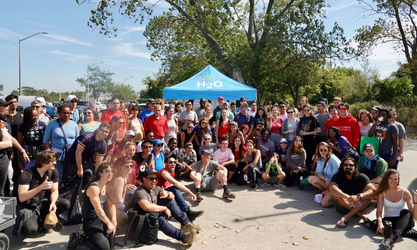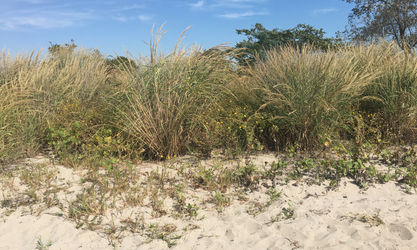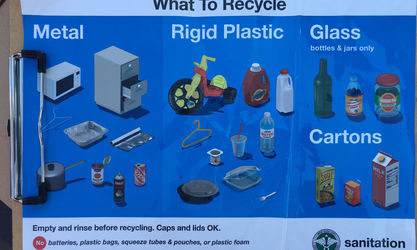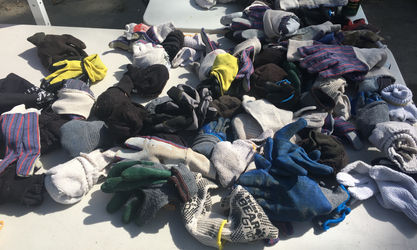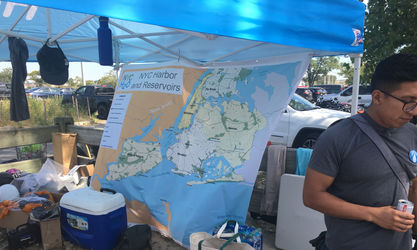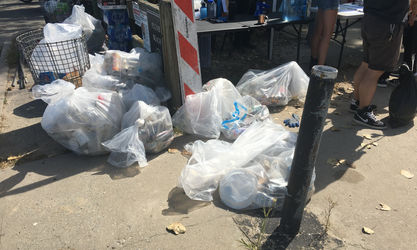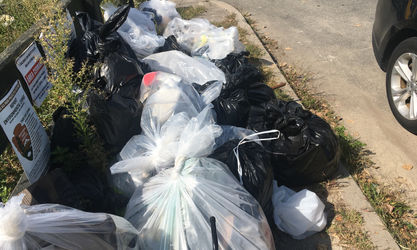Plumb Beach Clean-Up Experience
Through participating in the Plumb Beach Clean-Up, I was able to gain a better sense of the environmental issues facing New York City's waterfront. I could definitely see myself participating in another clean-up or similar activity, as I saw how grave the problem truly is. I also realized that my efforts made a difference, as the beach was significantly cleaner afterwards.
Once arriving at the beach, our class was informed as to how we would proceed. In addition to working with NYCH20, we also assisted Engines for Change in their efforts to categorize the recycling. We were split into teams of 3, where one of us would hold the bags--one for recycling and one for trash, one of us picked up the items from the beach, and one person categorized the items on the app. The information regarding the waste picked up, such as quantities of each item, will be used to monitor the status of the beach. My job was to pick up the items from the beach. During the 2 hours, we picked up approximately 40 pounds of either trash or recycling. The most common items we found were cigarette butts, food wrappers, bottles, and bottle caps. These small items pose a significant risk to wildlife, as birds and other animals can eat them or choke on them.
My service heightened my awareness of the issues facing the waterfront because I realized the extent of the pollution. It was my first time visiting a New York beach, and Plumb Beach had a lot more litter than any Massachusetts beach I have been to. I was particularly shocked by the number of cigarette butts on the beach, as I personally view smoking as an outdated practice. When cleaning the beach, I picked up hundreds of cigarette butts, with hundreds more remaining on the beach and in the dunes. In 2 hours, our groups removed a few hundred pounds of trash and recycling from the beach. If this effort was magnified across society, a great amount of change could be achieved.
In the future, I intend to make a difference in the environment where I can. By witnessing the state of Plumb Beach prior to our clean-up, I saw just how destructive pollution is--it made a beautiful natural area significantly less nice. Therefore, I will be sure not to litter, and to prevent others from littering whenever possible. As stated above, I would be interested in attending another beach clean-up, as I saw the true impact of only 2 hours of my time. Climate change is an issue that will especially impact my generation and those after me, so I feel it is my civic duty to spend some of my time repairing the damage human's have done to our environment.
I have done various types of service before, but have never engaged in a beach clean-up. This experience was enlightening, and heightened my awareness of the issues facing the New York City waterfront. I also felt as if I genuinely made a difference in the cleanliness of the beach going forward. Our time was spent not just beautifying the beach, but also making it a better habitat for surrounding wildlife. Thus, the impact of our work extends beyond the aesthetics of the beach and into a healthier ecosystem. For these reasons, I am grateful for my experience cleaning up Plumb Beach.
History of New York Conservation
The history of conservation in New York City dates back to 1733, when Bowling Green Park was established ("Oldest Parks" par. 2). As the city developed, small parks were established in neighborhoods. However, as the grid system for Manhattan was established, there was little open space. The city then allocated 840 acres to the building of Central Park, making it the first urban landscaped park in the US (Waxman par. 1-3). The park is home to thousands of different species of animal and plant life. New York City has allotted approximately 28,000 acres for public parks, with the largest being the Bronx's Pelham Bay Park. It has historical ties to the Revolutionary War, and has served as a Naval training base. Pelham Bay Park is home to a couple of wildlife sanctuaries, and officially became a park in 1888 (Owuor Otieno par. 2-6). The city has consistently shown its appreciation for the environment through the creation and upkeep of its many public parks.
The state has demonstrated environmental concern through the creation of a series of government agencies aimed at protecting New York's wildlife. The first of such groups was the appointing of conservation officers to enforce the state's hunting laws in 1880. In 1885, the first Forest Preserve was established by the State Legislature, and it protected areas in the Adirondacks and the Catskills. In 1911, the Fisheries, Game, and Forest Commission was combined with a few other small environmental agencies to form the Conservation Commission. This commission was more expansive, and allowed for further protection and maintenance of New York's wildlife. Finally, the Department of Environmental Conservation was formed in 1970--on the nation's first Earth Day, and serves to combat more recent environmental concerns, such as the changing climate ("History of DEC" par. 1-8).
At the federal level, environmental conservation efforts picked up with President Theodore Roosevelt's passing of the Antiquities Act in 1906. This allowed presidents to set aside historic land for the creation of national monuments. President Woodrow Wilson created the National Parks Service in 1916 in order to manage national parks and conservation sites. Because of the Antiquities Act and the National Parks Service, the United States now has 84.9 million acres of national parks, or 3.6% of the country's land (History.com Editors, par. 12-19). The next major progression in American conservation was the formation of the Environmental Protection Agency in December of 1970, under President Richard Nixon's administration. The EPA forms laws and regulations to promote the health of citizens and the purity of the environment. It provides billions in funding to communities to ensure safe drinking water and clean soil. Regarding the formation of the EPA, President Nixon said the following to Congress: "The Congress, the Administration and the public all share a profound commitment to the rescue of our natural environment, and the preservation of the Earth as a place both habitable by and hospitable to man"("Quotations" par. 9-10). To this day, the EPA serves a crucial role in federal conservation efforts.
As time has passed, conservation has become more important in New York City, New York State, and the entire United States. Concern about the environment has reached a worldwide stage, especially with the recent United Nations Climate Change Summit in New York. Service and conservation are both valuable methods in ensuring that the Earth remains naturally beautiful for centuries to come.
Works Cited
“History of DEC.” History of DEC - NYS Dept. of Environmental Conservation, Department of Environmental Conservation,
https://www.dec.ny.gov/about/9677.html.
History.com Editors. “National Park Service.” History.com, A&E Television Networks, 27 Mar. 2018,
https://www.history.com/topics/us-government/national-park-service.
Owuor Otieno, Mark . "The Largest Parks in New York City." WorldAtlas, Sept. 28, 2017, worldatlas.com/articles/the-
largest-parks-in-new-york-city.html.
“Quotations about the Environment.” EPA, Environmental Protection Agency, 13 June 2019,
https://www.epa.gov/history/quotations-about-environment.
“The Oldest Parks (1686-1811).” The Oldest Parks : Online Historic Tour : NYC Parks, NYC Parks,
https://www.nycgovparks.org/about/history/timeline/oldest-parks.
Waxman, Sarah. “History of Central Park, New York.” NewYork.com, 1994,
https://www.ny.com/articles/centralpark.html.
